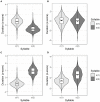Phonetic Realizations of Metrical Structure in Tone Languages: Evidence From Chinese Dialects
- PMID: 35911037
- PMCID: PMC9326321
- DOI: 10.3389/fpsyg.2022.945973
Phonetic Realizations of Metrical Structure in Tone Languages: Evidence From Chinese Dialects
Abstract
In tone languages, some case studies showed that the word-level tonal representation was closely related to the underlying metrical pattern. Based on different tonal patterns in prosodic units, the metrical structures could generally be divided into the left- and right-dominant types in Chinese dialects. Yet the cross-dialectal phonetic realizations (e.g., duration and pitch) between or within these two metrical structures were still unrevealed. The current study investigated the duration and pitch realizations of disyllabic prosodic words in Changsha and Chengdu dialects (the left-dominant structure), and in Fuzhou and Xiamen dialects (the right-dominant structure). Results showed that not all the duration patterns across four Chinese dialects were sensitive to different metrical structures, indicating that the duration might not be the universal cue for metrical prominence in Chinese dialects. In terms of pitch realization across all the four Chinese dialects, level tones (sometimes falling tones) generally appeared in the metrically weak unit, while underlying pitch forms appeared in the metrically strong unit. Compared with duration, pitch might be more robust for prosodic realizations of metrical structures in Chinese dialects. Furthermore, there was an interaction between duration and pitch patterns in Chinese dialects, which could shed new light on the phenomenon of "metrical tone sandhi". Meanwhile, this study also provides some references for the judgment of the metrical stress and prosodic realizations in other Chinese dialects.
Keywords: Chinese dialects; duration; metrical structure; metrical tone sandhi; pitch.
Copyright © 2022 Guo and Chen.
Conflict of interest statement
The authors declare that the research was conducted in the absence of any commercial or financial relationships that could be construed as a potential conflict of interest.
Figures







Similar articles
-
Atypical prosodic realization by Mandarin-speaking autistic children: Evidence from tone sandhi and neutral tone.J Commun Disord. 2022 Nov-Dec;100:106280. doi: 10.1016/j.jcomdis.2022.106280. Epub 2022 Nov 13. J Commun Disord. 2022. PMID: 36384065
-
Focus encoding and prosodic structure in Shanghai Chinese.J Acoust Soc Am. 2017 Jun;141(6):EL610. doi: 10.1121/1.4989739. J Acoust Soc Am. 2017. PMID: 28679266
-
The Sequence Recall Task and Lexicality of Tone: Exploring Tone "Deafness".Front Psychol. 2022 Jul 12;13:902569. doi: 10.3389/fpsyg.2022.902569. eCollection 2022. Front Psychol. 2022. PMID: 35910979 Free PMC article.
-
Word-level prosodic and metrical influences on Hawaiian glottal stop realization.Phonetica. 2023 Jun 15;80(3-4):225-258. doi: 10.1515/phon-2022-0031. Print 2023 Jun 27. Phonetica. 2023. PMID: 37312566
-
Pitch accent alignment in romance: primary and secondary associations with metrical structure.Lang Speech. 2005;48(Pt 4):359-96. doi: 10.1177/00238309050480040301. Lang Speech. 2005. PMID: 16715682 Review.
References
-
- Archibald J. (2009). Phonological feature re-assembly and the importance of phonetic cues. Second Lang. Res. 25, 231–233. 10.1177/0267658308100284 - DOI
-
- Bartoń K. (2022). MuMIn: Multi-Model Inference (1.46.0). R Package. Available online at: https://CRAN.R-project.org/package=MuMIn
-
- Bates D., Mächler M., Bolker B., Walker S. (2015). Fitting linear mixed-effects models using lme4. J. Stat. Softw. 67, 1–48. 10.18637/jss.v067.i01 - DOI
-
- Boersma P., Weenink D. (2021). Praat: Doing Phonetics by Computer [Computer program] (Version 6.1.56). Available online at: https://www.praat.org.
LinkOut - more resources
Full Text Sources

